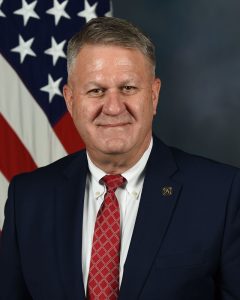
DOUBLE TIME: The IVAS program went from a concept to a rapid fielding decision in two years thanks to iterative, Soldier-focused design, alternative acquisition methods and innovations that leveraged existing technology. (Photo by Sgt. Robert Whitlow, 49th Public Affairs Detachment)
FROM THE DIRECTOR OF
ACQUISITION CAREER MANAGEMENT
RONALD R. RICHARDSON JR.
MTA and OTA speed the process of getting the best equipment into the hands of our Soldiers.

Seven years.
That’s how long it used to take to go from a materiel development decision—the point at which a capability gap has been identified and a decision has been made to find a materiel solution—to milestone C—the time when a decision must be made to enter the materiel solution into production and deployment. Over the years, we’ve seen programs that met every requirement, only to be canceled or restructured when they got into operational testing because they were too expensive or weren’t what the users wanted. We would go forward chasing a requirement that drove cost, complexity,
time and schedule. Everyone had a say and anyone could slow you down. Acquisition was viewed by many in the operational force as a monolithic, bureaucratic and slow-rolling process that maybe would give our warfighters what they need.
Seven years…Maybe.
I believe that no American Soldier should ever be in a fair fight, anywhere—they should always have the advantage. The best way to equip our Soldiers with the latest technology and game-changing capability today is through an iterative process that gives us the ability to look left and right—to expand our aperture, rather than moving forward with our heads down.
Alternative acquisitions give us that ability. The Adaptive Acquisition Framework (AAF) includes a variety of pathways that enable us to deliver effective, suitable, survivable, sustainable and affordable solutions to users in a timely manner. For example, the middle tier of acquisition (MTA) is one pathway within the framework that can be used to rapidly develop fieldable prototypes. There is also a full spectrum of available contract strategies and tools that can be leveraged based on environment, constraints and desired outcomes. Other-transaction authority (OTA) is one such tool that allows us to accelerate delivery of that capability to the force and better enable the Army to have access to cutting-edge technologies.
Two years.

TAKE NOTES: Soldier-centered design led to simple adjustments of the IVAS throughout its development, helping mitigate technical risk and ensuring the end product was what Soldiers wanted. (Photo by Courtney Bacon, PEO Soldier)
ALTERNATIVES AT WORK
In my time working at the Program Executive Office (PEO) for Soldier, I saw the Integrated Visual Augmentation System (IVAS) program go from a concept to a rapid fielding decision in two years, thanks to the rapid-prototyping cycle leveraged through the use of MTA. The project manager was able to get started on the program right away, and worked closely with the Lethality Cross-Functional Team to iterate on the program through multiple Soldier touch points. This collaboration allowed them to simultaneously refine the requirements and the product, rapidly move into production, and ultimately field a product that was built with Soldier feedback every step of the way.
That Soldier-centered design led to simple adjustments along the way that helped mitigate technical risk and ensured the end product would be precisely what the users wanted. The use of other-transaction authority connected us with nontraditional defense manufacturers who were right in the field with the program, hearing Soldier feedback directly, and quickly implementing changes. The program wasn’t tied to a specific design from the outset, and was therefore able to fail early, make adjustments, leverage the trade space, and ultimately get out a really good product in an incredibly short period of time.
Looking ahead, we should see shorter time between program increments as well. Evolving technologies and ongoing Soldier touch points will drive more frequent updates to program requirements. We’ll be able to turn those requirements faster through rapid acquisition pathways, getting the latest equipment into the hands of Soldiers faster. Our approach to fleet management and how we manage capability sets will be especially important. That is where we’ll see real change in our ability to accelerate the delivery of capability to the force.
It’s important to me, as an Army acquisition professional, that I’m able to see a way to the end—to develop and have a good product in the hands of Soldiers in a few years. Alternative acquisition pathways are tools that help us do that. But, maybe most importantly, it allows us to focus on product development instead of document development. We will be able to accelerate the pace of programs, while also mitigating cost and performance risks, and leaders will be able to make timely decisions based on good information. Then we will truly be in position to deliver significant overmatch to the force.
CONCLUSION
The Army Acquisition Workforce is made up of experts and big thinkers. Alternative acquisition pathways empower us to think outside the box and have a real say in the process. I saw that firsthand with the IVAS program. People were lining up to work at PEO Soldier and be part of that team. We saw successes and people were genuinely excited.
We’re now seeing those successes leveraged across other programs. MTAs and OTAs are firmly in our dialogue, and our workforce is experiencing intense satisfaction from working with our users and the requirements community in a meaningful and collaborative way. This is a really rewarding time to be part of the acquisition workforce. I challenge you to work within the Adaptive Acquisition Framework to tailor strategies to deliver better solutions to our Soldiers faster.
For more information about the Adaptive Acquisition Framework, go to https://aaf.dau.edu/.







